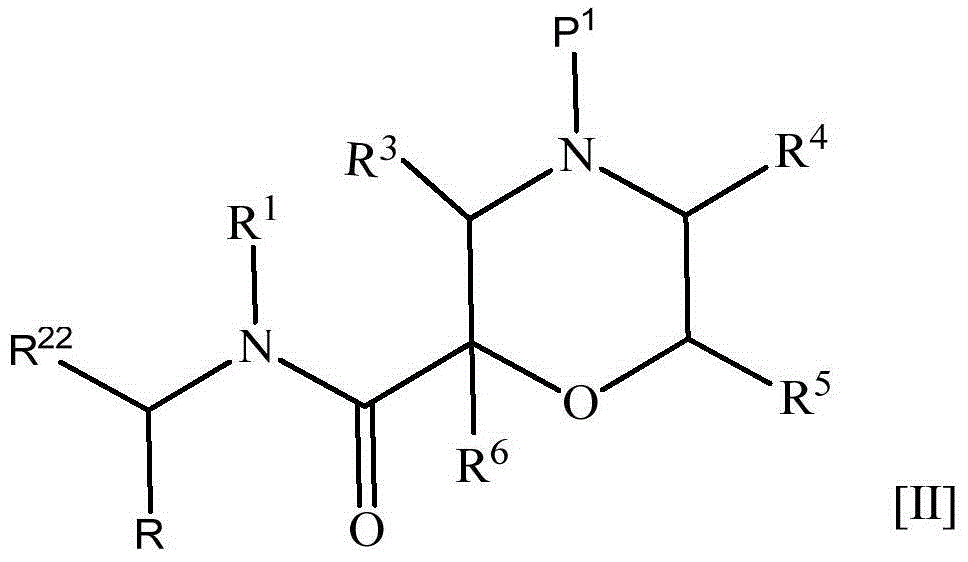Novel renin inhibitor
A halogen and compound technology, applied in the field of new compounds, can solve problems that do not involve the details of morpholine compounds, and achieve excellent renin inhibitory effect
- Summary
- Abstract
- Description
- Claims
- Application Information
AI Technical Summary
Problems solved by technology
Method used
Image
Examples
Embodiment 1
[0286] [chemical formula 5]
[0287]
[0288] (1) Under ice cooling, to (3-{3-[(1R)-1-(cyclopropylamino)ethyl]-6-methyl-1H-pyrazolo[3,4-b]pyridine- 1-yl}propyl)methyl carbamate (4.00g), and (2R,6S)-4-(tert-butoxycarbonyl)-6-(methoxymethyl)morpholine-2-carboxylic acid (3.66 g) N,N-dimethylformamide (80mL) solution, add 1-ethyl-3-(3-dimethylaminopropyl) carbodiimide hydrochloride (3.45g), 1-hydroxy Benzotriazole (1.63 g) was then stirred at room temperature for 5 hours. Saturated aqueous sodium bicarbonate solution was added to the reaction mixture, followed by extraction with ethyl acetate. The organic phase was washed successively with water and saturated brine, dried over sodium sulfate, and concentrated under reduced pressure. The obtained residue was purified by silica gel column chromatography (eluent: n-hexane / ethyl acetate=1 / 1→ethyl acetate) to obtain (2R,6S)-2-{cyclopropyl[(1R )-1-(1-{3-[(methoxycarbonyl)amino]propyl}-6-methyl-1H-pyrazolo[3,4-b]pyridin-3-yl)ethyl...
Embodiment 2
[0293] [chemical formula 6]
[0294]
[0295] (1) Under ice-cooling, (2R, 6S)-4-(tert-butoxycarbonyl)-6-(methoxymethyl)morpholine-2-carboxylic acid (7.59g) in dichloromethane (70mL) To the solution, diisopropylethylamine (9.60 mL) and diphenyl chlorophosphate (5.71 mL) were added, followed by stirring for 15 minutes under ice-cooling. Under ice-cooling, methyl (3-{4-[(1R)-1-(cyclopropylamino)ethyl]-6-methoxypyridin-2-yl}propyl)carbamate (5.65g ) in dichloromethane (20 mL), followed by stirring at room temperature for 20 hours. Under ice-cooling, saturated aqueous sodium bicarbonate solution was added to the reaction mixture, followed by extraction with chloroform. The organic phase was washed with saturated brine, dried over sodium sulfate, and concentrated under reduced pressure. The obtained residue was purified by silica gel column chromatography (eluent: n-hexane / ethyl acetate=1 / 1→ethyl acetate) to obtain (2R,6S)-2-{cyclopropyl[(1R )-1-(2-methoxy-6-{3-[(methoxycarbo...
Embodiment 3
[0300] [chemical formula 7]
[0301]
[0302] (1) Under nitrogen flow and ice cooling, add (2R,6S)-4-(tert-butoxycarbonyl)-6-(methoxycarbonyl)morpholine-2-carboxylic acid (289mg) to a dichloromethane solution (20mL ), diisopropylamine (523 μL), diphenyl chlorophosphate (415 μL) were added, and stirred under ice cooling for 30 minutes, after which, (3-{2-bromo-5-[(1R)-1-(cyclo A solution (3 mL) of methyl propylamino)ethyl]thiophen-3-yl}propyl)carbamate (361 mg) in dichloromethane was stirred at room temperature for 4 hours. A saturated aqueous sodium bicarbonate solution was added to the reaction solution, followed by extraction with chloroform. The organic phase was washed with saturated brine, and then dried over anhydrous magnesium sulfate, and the solvent was removed under reduced pressure. The resulting residue was purified by silica gel column chromatography (eluent: n-hexane / ethyl acetate=75 / 25→40 / 60) to obtain (2S,6R)-6-{[(1R)-1 -(5-Bromo-4-{3-[(methoxycarbonyl)am...
PUM
 Login to View More
Login to View More Abstract
Description
Claims
Application Information
 Login to View More
Login to View More - R&D Engineer
- R&D Manager
- IP Professional
- Industry Leading Data Capabilities
- Powerful AI technology
- Patent DNA Extraction
Browse by: Latest US Patents, China's latest patents, Technical Efficacy Thesaurus, Application Domain, Technology Topic, Popular Technical Reports.
© 2024 PatSnap. All rights reserved.Legal|Privacy policy|Modern Slavery Act Transparency Statement|Sitemap|About US| Contact US: help@patsnap.com










